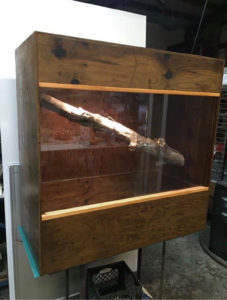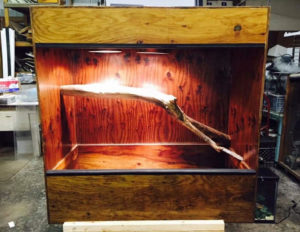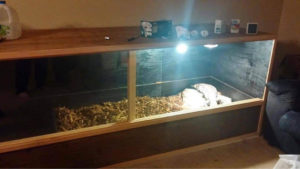Screen top aquariums are BAD for snakes.
This is an image from Petsmart showing what they recommend for a ball python. We will talk here about why this is BAD advice.
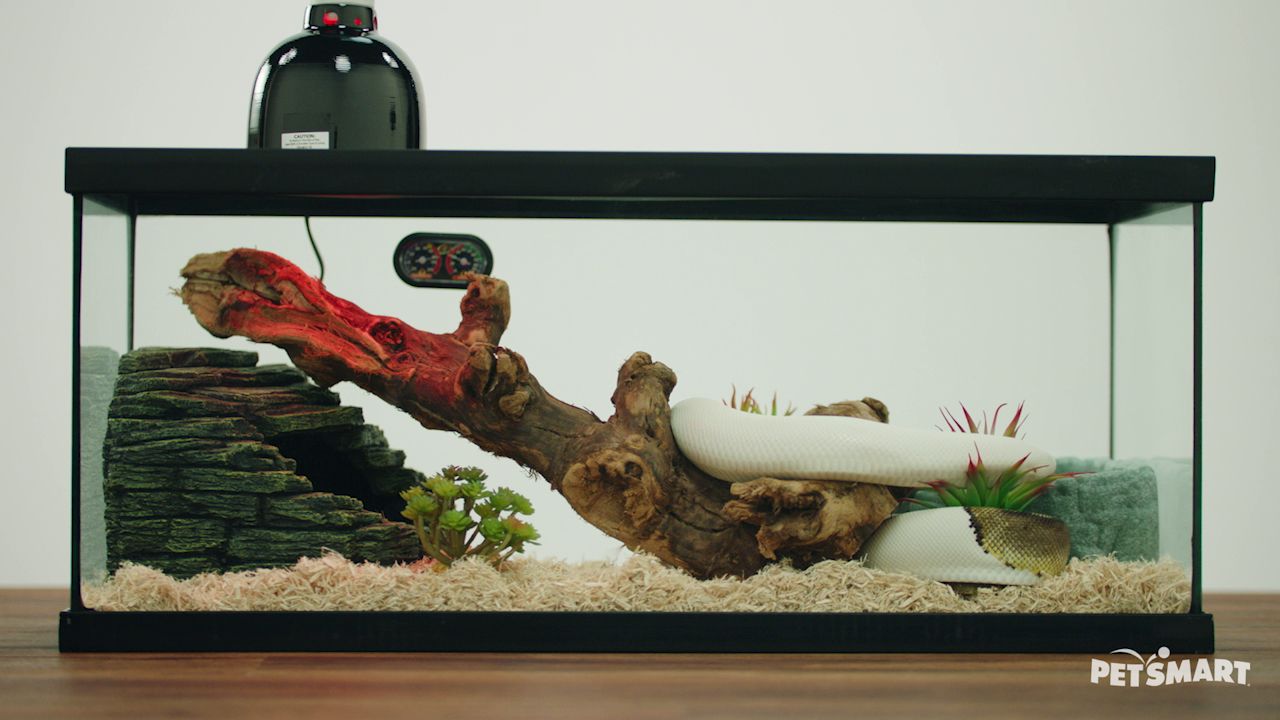
We are here to tell you the truth.
Screen Top Aquariums are NOT suitable for snakes unless modified. Screen top aquariums cause more health problems for snakes than anything else we’ve seen. They are very difficult to use properly and are not recommended. We feel so strongly about this at Snake Haus that that we will not allow our animals to be adopted out to a home that plans to use one.
This picture shows a snake that was kept in a screen top aquarium prior to being surrendered to Snake Haus. She suffered from all the problems listed on this page due to being kept in a screen top aquarium.
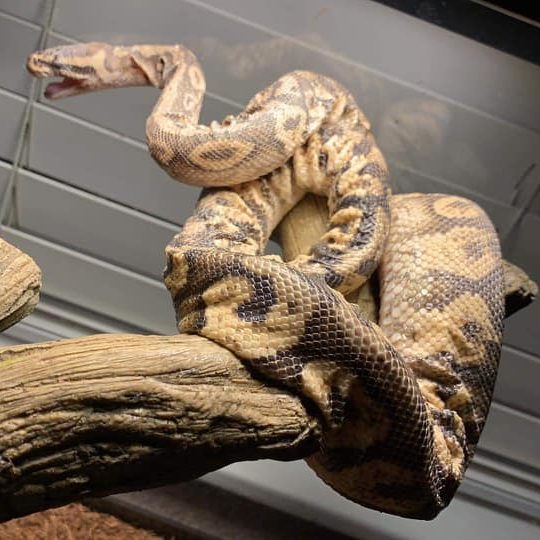
Here is the same snake only ONE WEEK LATER. The difference after just one week in a suitable enclosure is astounding. Screen top aquariums should NOT be used for snakes.

Why is it so common for people to keep snakes in aquariums?
Unfortunately all you see for sale at pets stores are glass aquariums. For some reason the pet industry is seriously mistaken about snake husbandry in captivity. Your pet snake would be better off kept in a plastic storage tub from the hardware store than in a screen top aquarium sold at pet stores.
Lets talk about why we don’t use screen top aquariums.
- Dehydration
Humidity is NOT the amount of water inside your enclosure. Rather, humidity is the amount of water VAPOR suspended in the air. Heat rises and water vapor goes with it. The screen top allows all that heat and water vapor to leave the enclosure out the top. As it rises past your snake it also draws moisture out of the animal’s body. This creates a strong convection effect that results in a very dehydrated animal.
Please visit the Humidity control page for more details on this.
2. Poor temperature regulation
Ineffective heating is one of the two most common causes of snake illness that we see. We have discovered through years of experience with many different snakes that it is harder to keep a snake warm than people realize. The heaters and thermometers sold with screen top aquariums might make it seem that you are succeeding in creating a warm enough environment for your snake. However what they lack is the ability to control the temperature in a way that translates to a warm SNAKE rather than just a warm enclosure.
Your goal in designing the inside climate of your enclosure is to give your snake a basking spot somewhere around 95 degrees, a warm side ambient temperature of 85 degrees, and a cold side ambient temperature of 75 degrees. Most screen top aquariums are either heated with a heat pad under it or a lamp on top – or both. The problem here is that HEAT RISES. A screen top allows that heat to leave right out the top of the enclosure.
This is PHYSICS guys. Combining a heat pad underneath an aquarium with a screen top results in strong convection action that carries heat and humidity right out the top. That forcibly draws heat and moisture out of your animal and often results in some of the most unhealthy animals we have ever seen. Adding a heat lamp only makes the problem worse.
Please visit the Climate control page for more details on this topic.
3. Scale Rot and respiratory disease:
This topic follows right along after heat and humidity. Unfortunately the battle to maintain the right climate for a snake in a screen top aquarium often leads to these two problems. Once people realize that it’s too cold inside the aquarium and add either belly heat or a CHE on top, the internal environment gets even dryer. The most common advise given by keepers to correct humidity is to start misting the substrate but this can cause a new problem to start.
We see so many discussions on-line about substrate choice. The most common reason people give for using certain substrate types is that they hold moisture and aid in boosting humidity. Unfortunately relying on your substrate to boost humidity results in an unbalanced environment. The screen top still allows heat and humidity to leave out the top so your air does not stay humid for long. Adding enough water to the substrate to keep the humidity up in a screen top aquarium results in substrate that is TOO WET. Now your snake must choose between perching in open air that is too dry or wallowing in soaked material that is too wet. Neither situation is healthy.
Another common reason people give for why they like deep substrate is that it absorbs and hides waste products. If you really stop to think what that means you should be grossed out! People who believe this to be good practice are being inadvertently fooled into thinking they don’t need to clean their snake’s enclosure as often. What really is happening however is that the snake is sitting in filth. Substrate saturated in urine and fecal material is a breeding ground for bacteria and produces noxious gases. The ammonia that rises into the air as that dirty wet substrate is heated can cause significant damage to the respiratory tract. That dirty wet substrate also causes sores and blisters on the skin which then get infected by the bacteria that thrives in that environment. Wait a minute – don’t we want our snakes to thrive instead of the bacteria??
Screen top aquariums make keeping your snake physically healthy so much more difficult than it should be.
4. Feeling of exposure
Most snakes are secretive animals. They are rarely found out in the open interacting with other animals or purposely showing themselves off. The most common reasons for a snake to be out in the open is too absorb heat from the sun or for the purposes of hunting. In those situations the snake might come out of hiding for a short amount of time to accommodate for those short term needs. Clear sides on a glass aquarium can make your snake feel vulnerable and may result in behavioral changes such as increased defensiveness, reduced hunting drive and therefor, poor appetite, or agitation shown as increased activity. Try to remember the saying – A HAPPY SNAKE IS A HIDING SNAKE! If your enclosure has all clear sides you might need to get creative to give your snake a better feeling of security.
Visit the Snake Behavior page if you are interested in learning more.
5. Nose damage
This problem can be caused by a few different aspects of the screen top aquariums. The heat and humidity rising out the top often causes the snake to try to follow that effect. They can feel their heat and humidity leaving out the top and some will try to follow it upward. This behaivor is often misunderstood as the snake’s enjoyment for climbing. Yes, many snakes are arboreal and will climb into and through trees. They will NOT do this to the extent that they push forcefully against their ceiling unless there is something wrong! If the floor of their enclosure is too wet and dirty as described above, they will often try to get out of the enclosure to get away from those uncomfortable and, sometimes, hazardous conditions. The snake might also try to get out through the screen top if they do not feel safe inside the enclosure. They are smart enough to understand that screen top is the way out and will work very hard to get through it if there is something wrong inside the enclosure.
This behavior causes damage to the snake’s nose and face. We jokingly call screen tops “Cheese graters” but I’m the first to admit that its really NOT funny. Unfortunately, when a snake pushes and rubs their face against a screen top they can sustain severe damage to their skin and underlying tissues that may even go bone deep. We have numerous surrenders at Snake Haus with varying degrees of facial scars and damage due to this problematic behavior. Can we please stop using cheese graters in snake enclosures?? That would be excellent.
These pictures show a boa missing a huge amount of tissue from his mouth due to rubbing on a screen top. He had many other health problems, the combination of which were too much for him to recover from. He was humanely euthanized.
6. Handling from above
Predators approach from above. Snakes may also be predators but most are NOT at the top of the food chain. The ones that are at the top, such as anacondas and reticulated pythons, are still vulnerable to predation when small. A screen top aquarium requires you to approach your snake from above. This is frightening to most snakes and causes undue stress.
This aspect is the ONLY thing that Exoterra enclosures having going for them. They have front open doors which are fantastic, but dang it, get rid of that screen top and cover those sides!
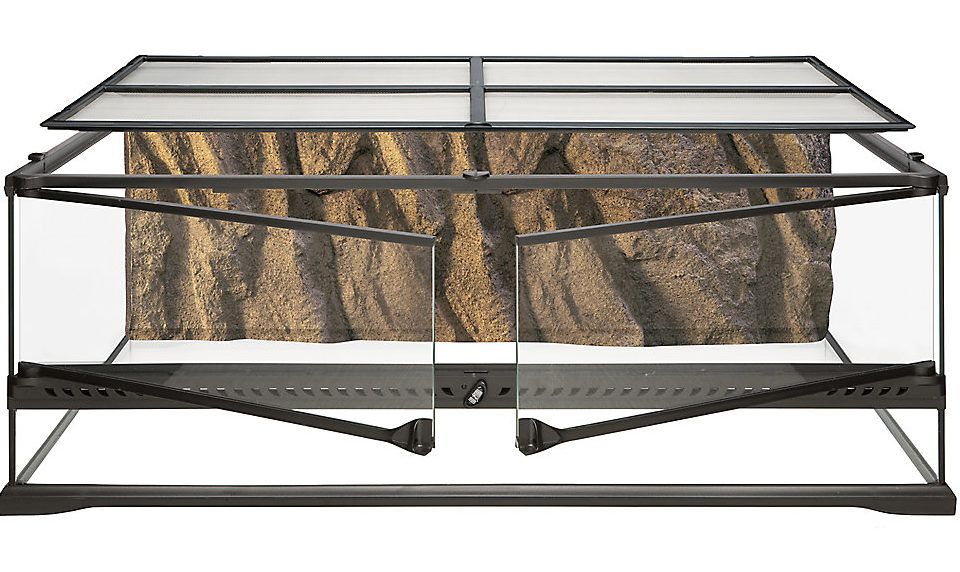
The Exoterra enclosures are easily improved by simply removing the screen and installing a solid top made out of plexiglass. The air gaps around the door are enough ventilation once you get your temps and humidity set right.
7. Inappropriate dimensions
Most aquariums are tall and narrow. We need to remember that snakes have no legs! Duh – I know that sounds silly but they do not stand up like other animals. They will utilize horizontal dimensions much more than vertical dimensions. Yes, some snakes climb but those arboreal snakes spend most of their time moving along sideways up in the canopy instead of moving up and down. The extra height in most glass aquariums is wasted space. The floor size is often too small for the snake that is stuck inside it.
General size recommendations for snakes are easy to figure out. They should have floor space that fits the following equations: length + width of the enclosure floor should = the length of the snake OR MORE. That means an adult ball python who is 5 feet long would need at least a 50 gallon aquarium to achieve the floor space that is needed – except the height of that 50 gallon aquarium just makes all these other problems listed on this page much harder to fix.
8. Danger from other animals
The final problem we see with screen tops is their vulnerability to other animals in the home. It is quite common to see cats sitting on top of snake cages. Many people find this funny but to the snake it is absolutely terrifying!! Holy moly – that house cat is one of nature’s more perfectly designed hunters and it should not be sitting on top of your snake and staring down at it. Talk about stressful situations – just imagine yourself stuck in a cage with someone who clearly wants to kill and eat you sitting on top of it staring down at you for hours. In addition we have seen many screen tops tear and cave in due this type of situation. They are NOT safe!
Alternatives
PVC Enclosures
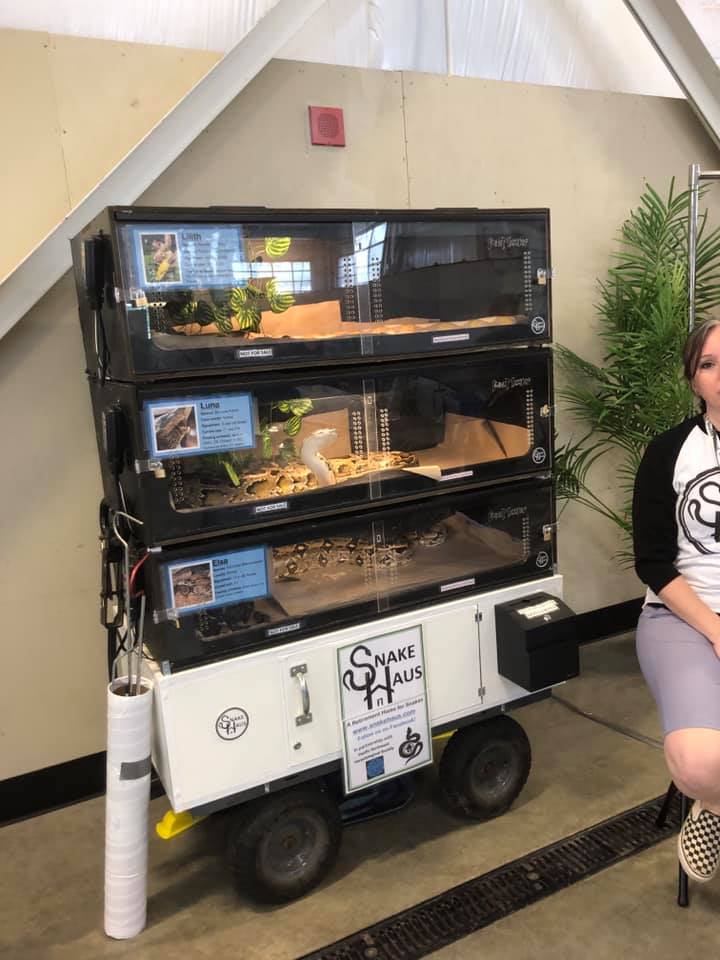
These are, by far, superior to anything else. They are light weight, water proof, easy to clean, and will last for decades. They are not commonly produced, however, and come with a price. If you can afford one of these, follow the links below. If you can not afford a PVC enclosure, keep scrolling to see other ways to create good enclosures.
Companies that sell PVC enclosures:
*NOTE* some of these come with SCREEN TOPS and will need to be modified
- Animal Plastics: https://apcages.com
- Boaphile: https://boaphileplastics.com/
- Vision cages: https://www.visionproducts.us
- Reptilekages https://reptilekages.com
- Zen Habitats: https://www.zenhabitats.com
- Reptile Basics: https://www.reptilebasics.com/reptile-cages/
- Apex Reptile: https://apexreptile.com/
- Black Box Cages: https://www.blackboxcages.com/collections/cages
- Dubia: https://dubiaroaches.com/collections/reptile-enclosures
- Focus Cubed Habitats: https://focuscubedhabitats.com/
- Cornel’s World: https://www.cornelsworld.com/
- Custom Reptile Habitats: https://customreptilehabitats.com/
Sealed Wood or Melamine
Building your own enclosure out of plywood or melamine is a cheaper alternative. This has some drawbacks, however, that go along with using less ideal materials. We build most of our own enclosures out of melamine due to the low cost and ease of construction. The most significant problem with wood enclosure is the inability to sanitize it. If you plan to use wood for your enclosure it needs to be sealed with a compound that is pet safe once cured. Melamine has a layer on it that can withstand regular cleaning and sanitizing but the edges need to be sealed.
Go here to view our plans for melamine enclosures: Build Your Own
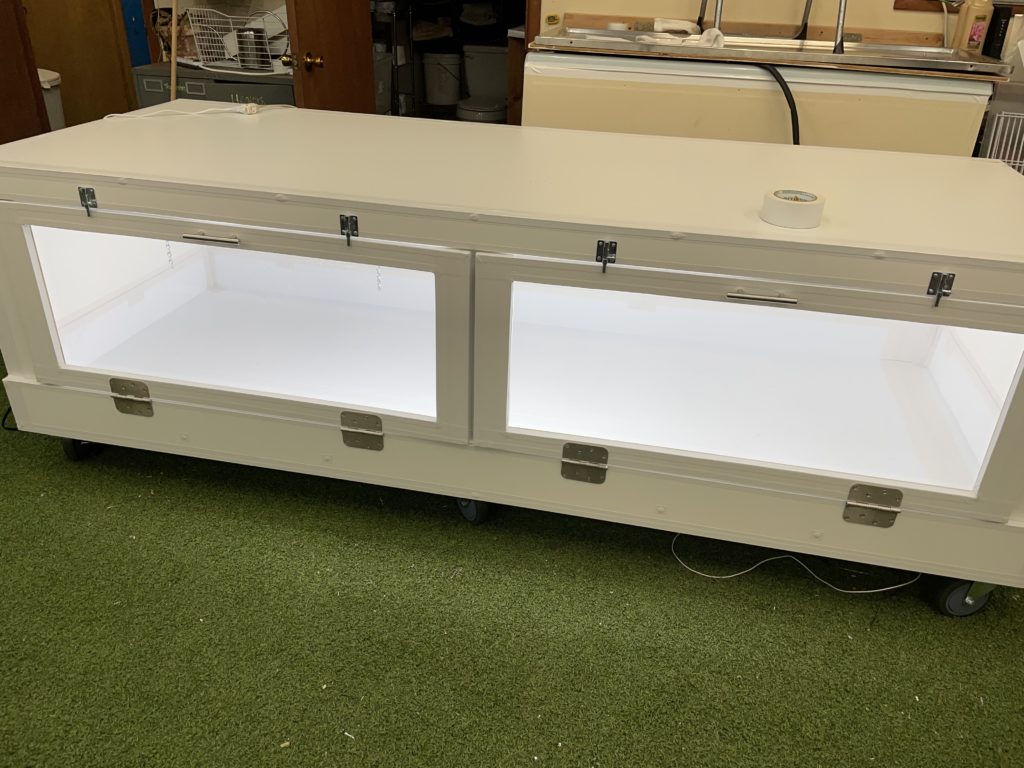
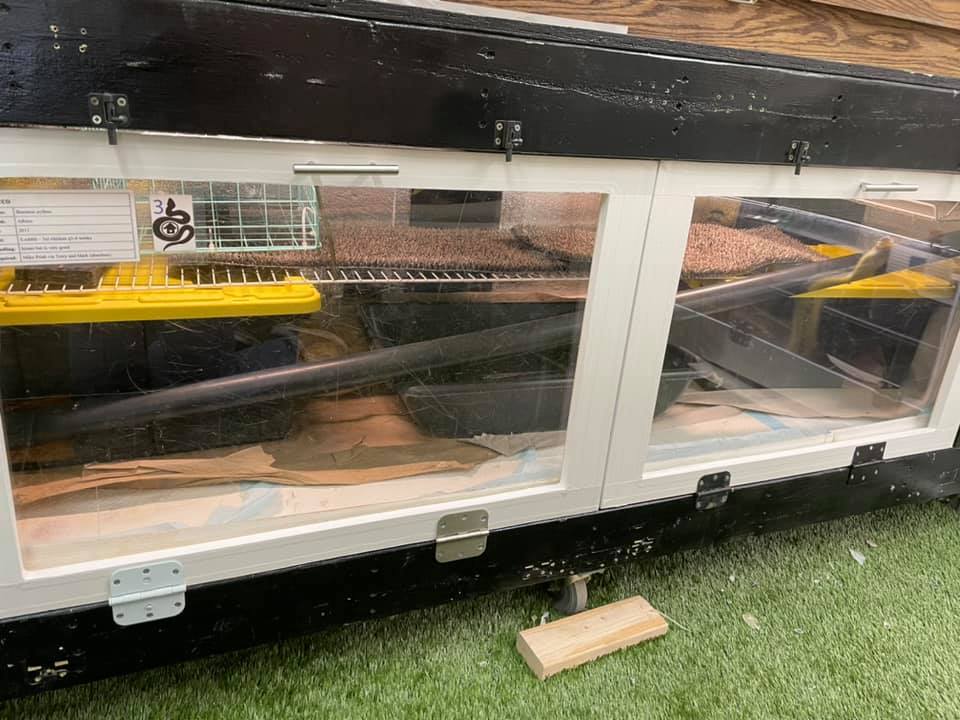
Display Cases
An old display case can be modified into a suitable enclosure as long as you choose one with good dimensions. Check dimensions carefully before purchasing one. Many are too narrow to be suitable. You can sometimes find one on Craigslist that is 24 inches front to back or larger. Furniture items that are only 16-18 inches deep such as book cases and china hutches should not be used. A tall but narrow enclosure is similar in shape to the aquariums and are not recommended unless used for very small snakes.
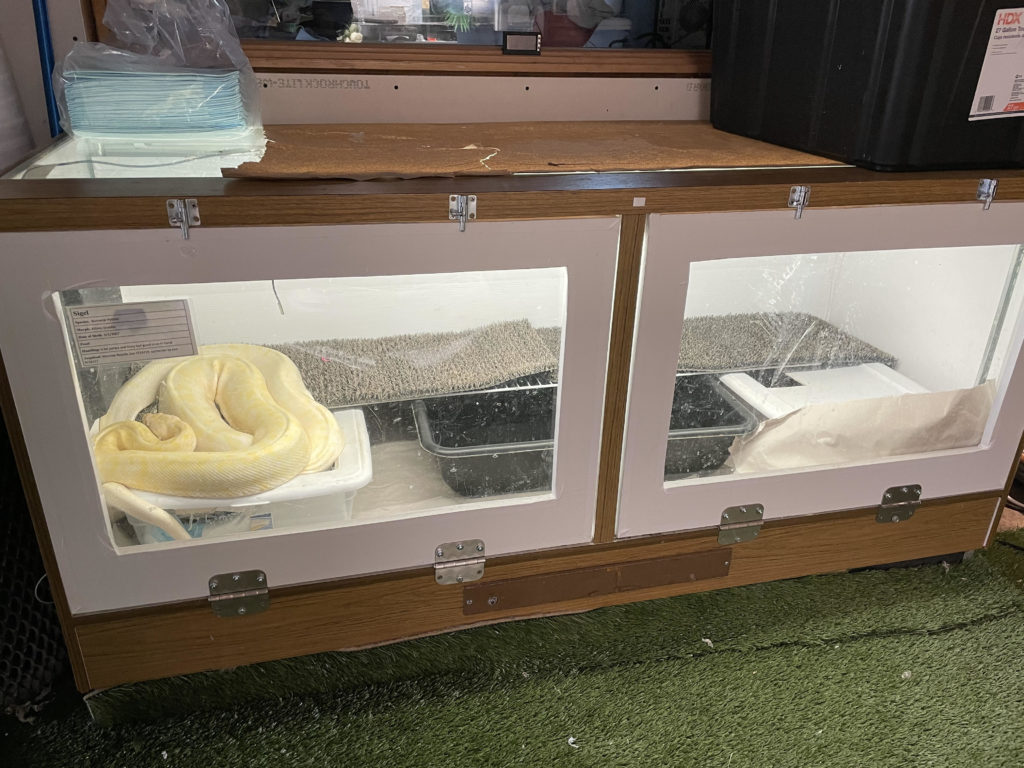
The Display Case page shows how we turned some of our display cases into a nice enclosures.
Modified Aquariums
Here’s where it gets interesting! Did you notice that we only say SCREEN TOP aquariums are bad? You can modify an aquarium to work for a snake with a little bit of work. This can be done with glass or acrylic aquariums and is an easy way to update an enclosure that you might already have. By simply turning them on their side and installing doors, you fix almost all of the problems.
Visit the Aquariums page to see examples of modified glass aquariums.
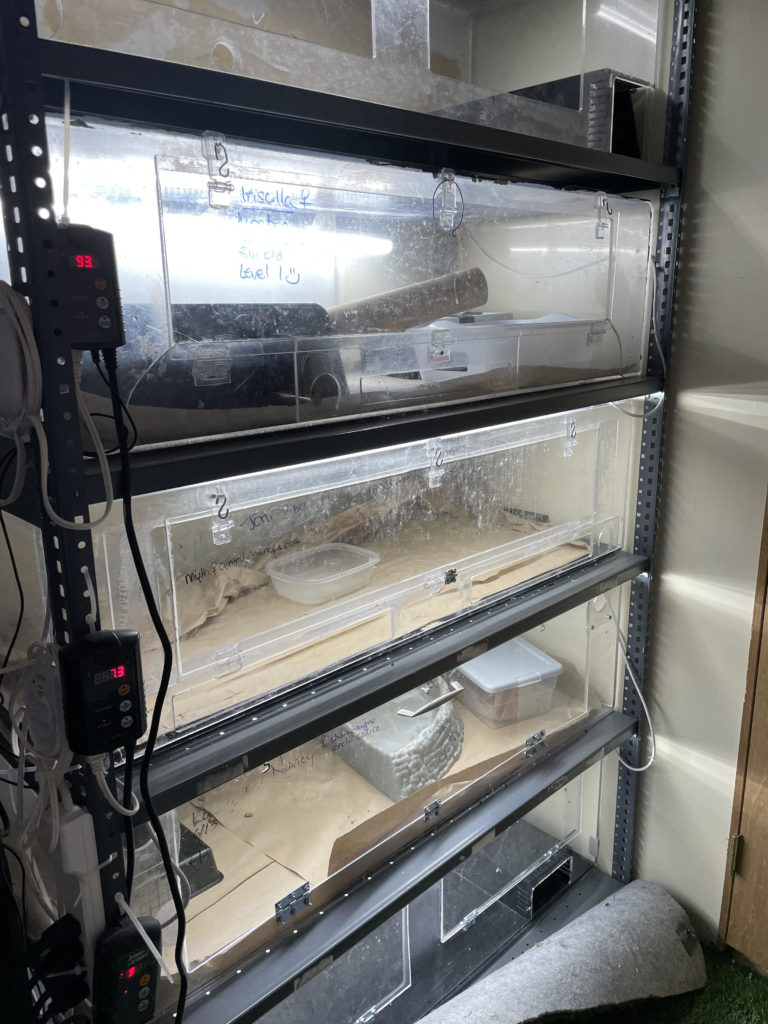
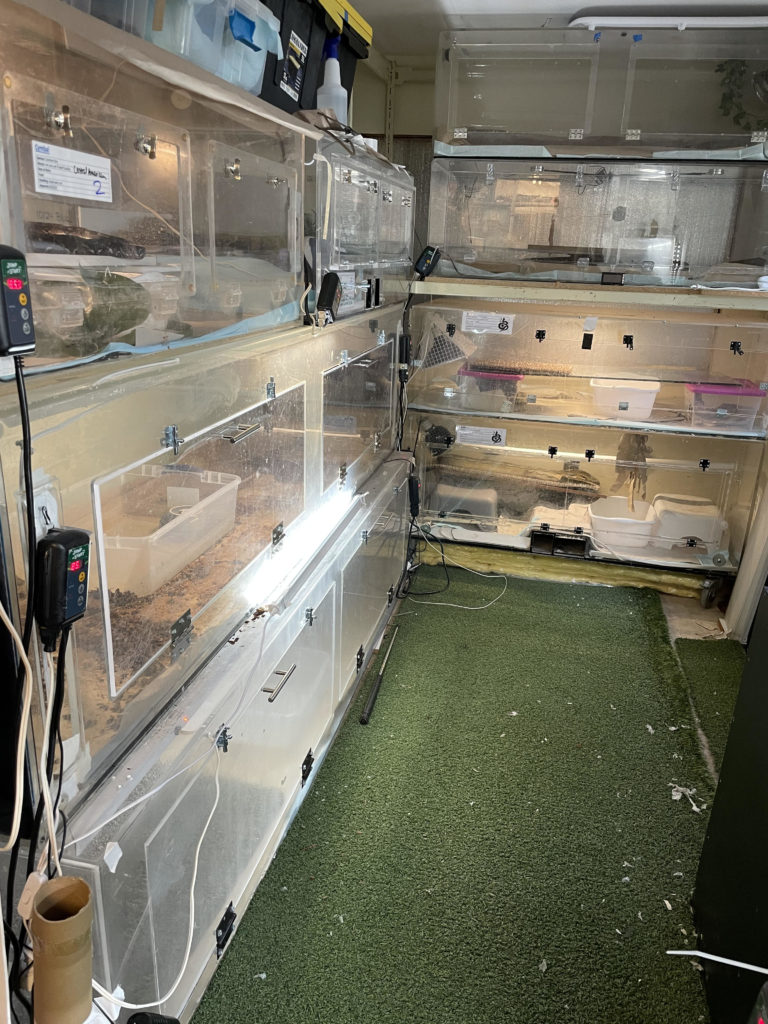
Plastic Tubs
The quickest and cheapest way to help a sick snake that has been in a screen top aquarium is to move them into a plastic tub. This is very easy to do and will help them quickly recover from significant dehydration or cold.
Visit the Plastic Tubs page to watch a video about how to create one.
Moral of the Story
Do not shop for snake enclosures at Pet Stores. You are unlikely to find suitable snake enclosures or supplies at a typical pet store.
Do not believe everything you read on the snake group and reptile sites. We have seen and heard so many people claim that screen top aquariums work well for them. Unfortunately, a snake successfully kept healthy in a screen top aquarium long term is not very common. It is too easy to make all the above mistakes.
The vast majority of cases we get at Snake Haus are snakes with illness, injury, or behavioral problems that we solved with husbandry changes. Getting the pet industry to stop recommending screen top aquariums for snakes would greatly reduce the number of pet snakes that are in need of help.
So lets spread the word! NO SCREEN TOPS!




